My next Decoded column looks at how assembly occupancies are addressed in the model codes, as well as some of the assembly-specific requirements related to door openings. Let me know if I missed anything! 🙂
This post will be published in Door Security + Safety

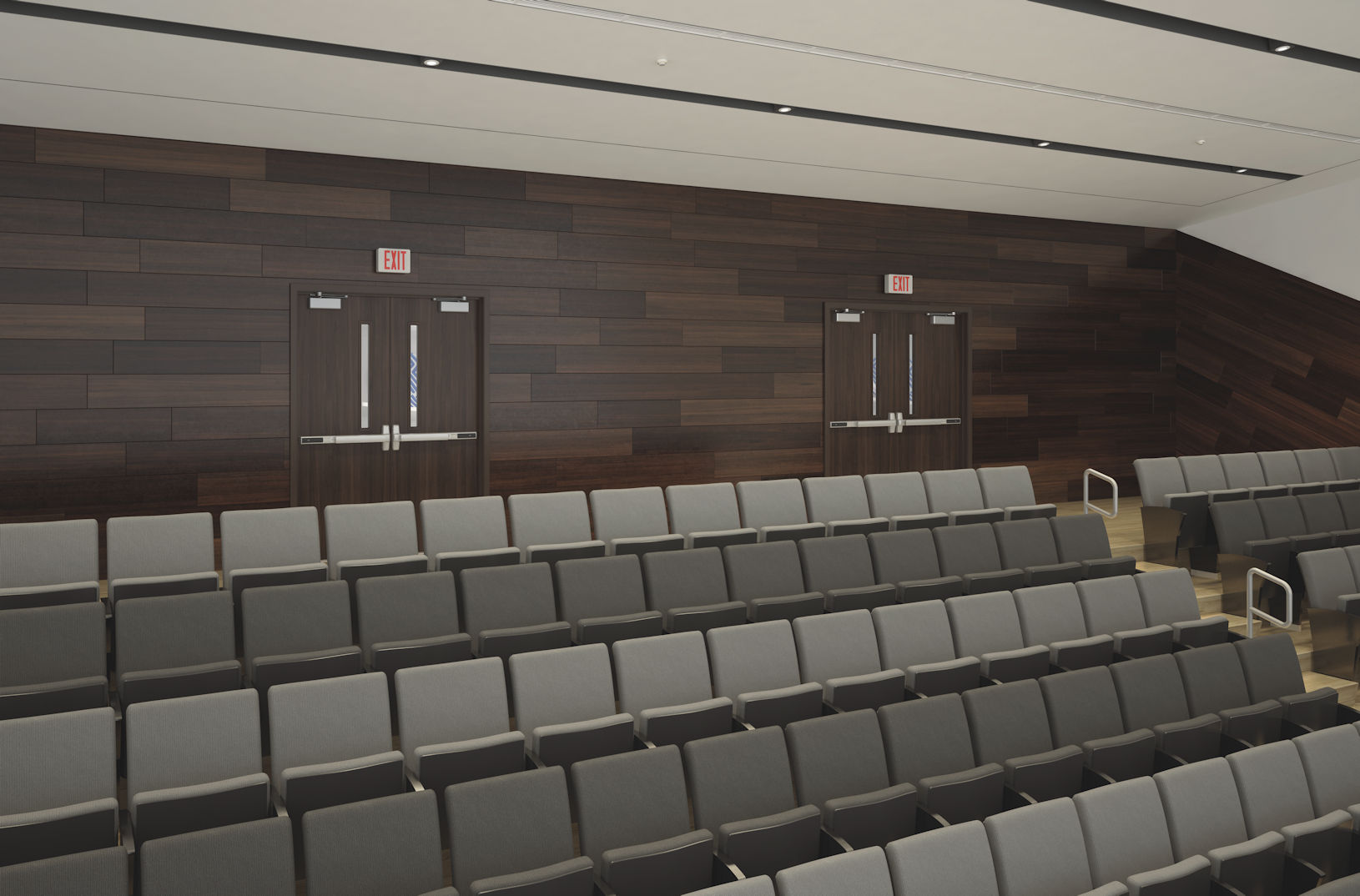 The model code requirements for swinging doors serving assembly occupancies help to ensure that large groups of people are able to exit quickly and safely during an emergency. Past tragedies have illustrated the importance of doors swinging in the direction of egress, equipped with hardware that will unlatch the door even if a group of building occupants is applying pressure to the door while attempting to exit in a panic.
The model code requirements for swinging doors serving assembly occupancies help to ensure that large groups of people are able to exit quickly and safely during an emergency. Past tragedies have illustrated the importance of doors swinging in the direction of egress, equipped with hardware that will unlatch the door even if a group of building occupants is applying pressure to the door while attempting to exit in a panic.
There are several code requirements that are specific to egress doors in assembly occupancies, but first, it’s important to understand how the model codes classify buildings or portions of buildings that are used as places of assembly.
NFPA Codes
NFPA 101 – Life Safety Code defines an assembly occupancy as: An occupancy (1) used for a gathering of 50 or more persons for deliberation, worship, entertainment, eating, drinking, amusement, awaiting transportation, or similar uses; or (2) used as a special amusement building, regardless of occupant load.
NFPA 101 addresses assembly occupancies in Chapter 12 – New Assembly Occupancies and Chapter 13 – Existing Assembly Occupancies. Examples of assembly occupancies include auditoriums, college and university classrooms with an occupant load of 50 people or more, libraries, and restaurants (refer to Annex A of NFPA 101 for many more examples).
A special amusement building, referenced in the definition above as an assembly occupancy, is a building that contains a system that carries passengers or that includes a walkway along a course for occupants to follow. In special amusement buildings, the egress path may be confusing because of special effects, or the means of egress may not be readily available because of the conveyance system carrying passengers. Examples of special amusement buildings include haunted houses, a ride (such as a roller coaster) within a building, a play structure – often with multiple levels, and other types of amusements that are enclosed with a building.
I-Codes
The International Building Code (IBC) and the International Fire Code (IFC) define assembly occupancies this way: Assembly Group A occupancy includes, among others, the use of a building or structure, or a portion thereof, for the gathering of persons for purposes such as civic, social or religious functions; recreation, food or drink consumption or awaiting transportation.
The I-Codes further divide Group A occupancies into five sub-groups:
- A-1 – assembly occupancies, usually with fixed seating, used for production and viewing of the performing arts or movies, including movie theaters and other types of theaters, symphony and concert halls, and TV and radio studios with an audience
- A-2 – assembly occupancies used for food/drink consumption, including banquet halls, gaming areas of casinos, nightclubs, taverns, and bars, restaurants, cafeterias, and similar dining facilities (including associated commercial kitchens)
- A-3 – assembly occupancies used for worship, recreation, or amusement and other assembly uses not classified as another Group A use group, including arcades, art galleries, bowling alleys, community halls, courtrooms, dance halls (without food or drink consumption), funeral parlors, lecture halls, libraries, museums, places of religious worship, waiting areas in transportation terminals, and gymnasiums, indoor swimming pools, and indoor tennis courts without spectator seating
- A-4 – assembly occupancies used for viewing of indoor sporting events and activities with spectator seating, including arenas, skating rinks, swimming pools, and tennis courts
- A-5 – assembly occupancies used for participation in or viewing outdoor activities, including amusement park structures, bleachers, grandstands, and stadiums
The I-Codes also address small assembly occupancies, such as fast-food restaurants and small cafes. When a building or tenant space used for assembly purposes has a calculated occupant load of less than 50 people, it is classified as a Group B business occupancy, rather than a Group A assembly occupancy. When an assembly space is less than 750 square feet in area or has an occupant load of less than 50 people and is accessory to another occupancy, the space is classified as Group B or as part of the occupancy that it is accessory to.
When a room or space that is used for assembly purposes is associated with a Group E educational occupancy, the assembly space may be considered Group E rather than Group A. According to the IBC Commentary, this is true when the assembly areas are used only by students and teachers as part of the educational occupancy. If the spaces are used by others – such as for community events – they would be classified as Group A.
Places of religious worship are considered Group A-3 occupancies. When a religious facility includes smaller rooms that are used for educational activities (religious classrooms or auditoriums with an occupant load of less than 100), these rooms may also be part of the Group A-3 classification. For example, religious educational rooms would normally be classified as Group B or Group E (depending on the age of the students), but the IBC considers these rooms Group A-3 as long as they are only used for religious education. If the rooms are used for other purposes, they would be classified based on the use.
In the IBC, special amusement areas are covered in Chapter 4 – Special Detailed Requirements Based on Occupancy and Use. When a special amusement area has a calculated occupant load of 50 people or more, it is considered an assembly occupancy. If the occupant load is less than 50 people, it is a business occupancy. The section of Chapter 4 pertaining to special amusement areas includes requirements related to automatic sprinkler and smoke detection systems, emergency voice/alarm communication systems, puzzle room exiting, marking of exits, photoluminescent exit signs, and interior finishes. This section does not apply to special amusement areas without walls or a roof that are constructed to prevent the accumulation of smoke.
Door Openings Serving Assembly Occupancies
S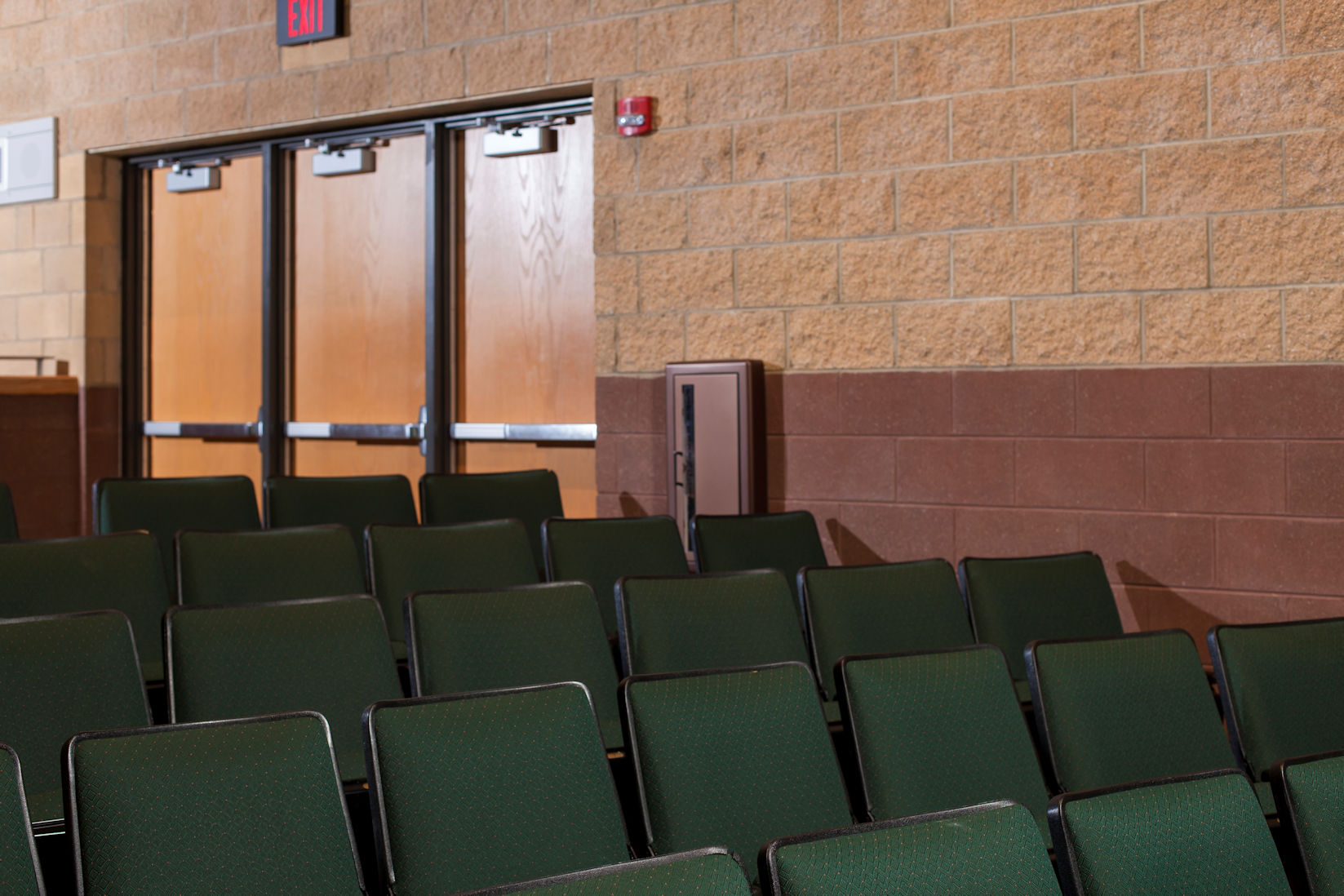 ome of the door-related considerations related to assembly occupancies include:
ome of the door-related considerations related to assembly occupancies include:
Occupant Load Factor – The occupant load factors included in the model codes are used to calculate the number of people that may occupy a space; requirements for egress are based on this calculated occupant load. When calculating the occupant load of an assembly occupancy, there are different factors that may be used depending on whether there is fixed seating, and how concentrated the occupants will be – for example, if there will be tables and chairs, rows of seats, or standing space. It’s important to choose the correct occupant load factor when calculating the occupant load.
Panic Hardware – When a door serving an assembly occupancy is equipped with a lock or latch, the I-Codes require the door to be equipped with panic hardware or fire exit hardware if the calculated occupant load of the space is 50 people or more. For the NFPA codes, panic hardware is required for these doors when the calculated occupant load is 100 people or more. If the door is not equipped with a lock or latch, panic hardware is not required by the model codes (ex. push plates and pulls are acceptable). There are additional occupancy types and rooms that also require panic hardware when the occupant load is over a certain threshold.
Key-Operated Locks – If certain criteria are met, the main exit door or doors serving some occupancy types are allowed to have key-operated locks (double cylinder deadbolts). On assembly occupancies, the I-Codes limit this application to main exit doors serving an area with a calculated occupant load of 300 people or less. The NFPA codes allow these locks on assembly occupancies with less than 500 occupants. The common interpretation of this code section is that the key-operated lock would be used as an alternative to the panic hardware. The key-operated lock must be readily distinguishable as locked, and signage is required; refer to the adopted code for specific requirements.
Delayed Egress Locks – Although the NFPA codes allow delayed egress locks on doors serving assembly occupancies with the exception of the main entrance/exit doors, the I-Codes are more restrictive. The IBC does not allow delayed egress locks on doors serving Group A occupancies, except for secondary egress doors serving courtrooms that are equipped with an automatic sprinkler system. This change was made in the 2018 edition of the IBC; prior editions did not allow delayed egress locks in courtrooms.
Luminous Egress Path Markings – The model codes require some doors to have luminous markings indicating the means of egress, including luminous paint or tape around the door frame as well as the hardware used to release the latch. Where required by code, these markings are typically found within exit enclosures, on doors that building occupants must pass through to complete the exit path. According to the IBC, the requirement for luminous egress path markings applies to high-rise buildings in certain use groups, including Group A.
Automatic Operators on Accessible Public Entrances – A change to the 2021 edition of the IBC requires accessible public entrances for some types of buildings to have automatic doors, including assembly occupancies (except Group A-5) when the calculated occupant load is greater than 300 people. This change mandates at least one automatic door/one set of automatic doors (exterior and vestibule) at each accessible public entrance in these buildings.
Conforming to the adopted codes will help to ensure the safety of building occupants in assembly occupancies. For more information on these requirements, there are past Decoded articles addressing each of the topics summarized above. State or local codes may include modifications to the model codes, and the Authority Having Jurisdiction will make the final determination with regard to code compliance.
You need to login or register to bookmark/favorite this content.

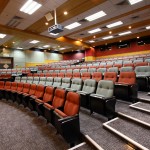
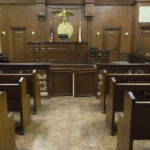
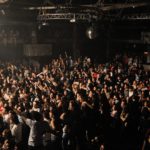





Leave A Comment